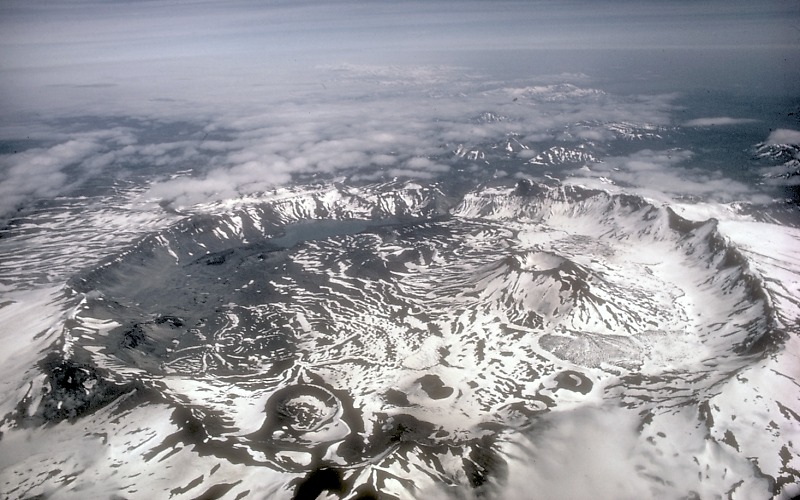- caldera
- ALASKA VOLCANO OBSERVATORY GLOSSARY
A large crater formed by collapse or subsidence of the ground surface following a great eruption. During a typical caldera-forming eruption, the magma chamber is partially emptied and large amounts of ash and pyroclastic debris are extruded.\GLOSSARY OF VOLCANIC TERMSLarge, circular to elongate, volcanic collapse depressions that form from the rapid extrusion of magma form a shallow subterranean magma chamber. In general, the diameter of a caldera is much greater than any of its individual volcanic vents (Williams and McBirney, 1979, p. 207).\USGS PHOTO GLOSSARY OF VOLCANIC TERMSA caldera is a large, usually circular depression at the summit of a volcano formed when magma is withdrawn or erupted from a shallow underground magma reservoir. The removal of large volumes of magma may result in loss of structural support for the overlying rock, thereby leading to collapse of the ground and formation of a large depression. Calderas are different from craters, which are smaller, circular depressions created primarily by explosive excavation of rock during eruptions.\
 Photograph by M. Williams, National Park Service, 1977.Aniakchak Caldera, pictured here, formed during an enormous explosive eruption that expelled more than 50 km3 of magma about 3,450 years ago. The caldera is 10 km in diameter and 500-1,000 m deep. Subsequent eruptions formed domes, cinder cones, and explosion pits on the caldera floor.\Did you know?• At least 1,299 episodes of unrest have occurred at 138 calderas greater than 5 km in diameter during historical time.• In a typical year some form of unrest (earthquakes, ground deformation, change in fumarole activity, or eruptions) occurs at about 18 large calderas worldwide, and eruptions occur within or near at least five of them.• The largest eruption of the 20th century from the Novarupta vent in the Valley of 10,000 Smokes of Alaska, ejected about 12 km3 of magma and resulted in the formation of a caldera 3 km across. Amazingly, the caldera collapse didn't occur at the eruption vent, but 10 km away at Katmai, a stratovolcano! Apparently magma drained away from Katmai's magma reservoir to Novarupta's erupting vent.• Yellowstone National Park consists of three enormous calderas that erupted about 2, 1.2, and 0.6 million years ago. The most recent caldera is 45 km across and 75 km long!• Caldera-forming eruptions are the largest eruptions on Earth. For example, the Fish Canyon eruption in southwestern Colorado (United States) about 28 million years ago erupted more than 5,000 km3 of magma from La Garita caldera. That's enough magma to bury the entire state of California to a depth of nearly 12 m!
Photograph by M. Williams, National Park Service, 1977.Aniakchak Caldera, pictured here, formed during an enormous explosive eruption that expelled more than 50 km3 of magma about 3,450 years ago. The caldera is 10 km in diameter and 500-1,000 m deep. Subsequent eruptions formed domes, cinder cones, and explosion pits on the caldera floor.\Did you know?• At least 1,299 episodes of unrest have occurred at 138 calderas greater than 5 km in diameter during historical time.• In a typical year some form of unrest (earthquakes, ground deformation, change in fumarole activity, or eruptions) occurs at about 18 large calderas worldwide, and eruptions occur within or near at least five of them.• The largest eruption of the 20th century from the Novarupta vent in the Valley of 10,000 Smokes of Alaska, ejected about 12 km3 of magma and resulted in the formation of a caldera 3 km across. Amazingly, the caldera collapse didn't occur at the eruption vent, but 10 km away at Katmai, a stratovolcano! Apparently magma drained away from Katmai's magma reservoir to Novarupta's erupting vent.• Yellowstone National Park consists of three enormous calderas that erupted about 2, 1.2, and 0.6 million years ago. The most recent caldera is 45 km across and 75 km long!• Caldera-forming eruptions are the largest eruptions on Earth. For example, the Fish Canyon eruption in southwestern Colorado (United States) about 28 million years ago erupted more than 5,000 km3 of magma from La Garita caldera. That's enough magma to bury the entire state of California to a depth of nearly 12 m!
Glossary of volcanic terms. - University of Wisconsin Oshkosh. G. J. Hudak. 2001.
